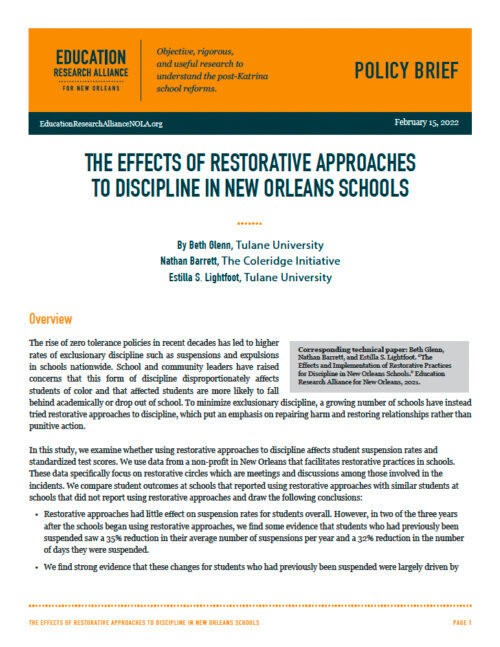The Effects of Restorative Approaches to Discipline in New Orleans Schools
This study by Beth Glenn, Nathan Barrett, and Estilla S. Lightfoot finds that non-punitive restorative practices had the greatest impact on previously suspended students.

The Effects of Restorative Approaches to Discipline in New Orleans Schools
Published
by Beth Glenn, Nathan Barrett, Estilla S. Lightfoot
The rise of zero tolerance policies in recent decades has led to higher rates of exclusionary discipline such as suspensions and expulsions in schools nationwide. School and community leaders have raised concerns that this form of discipline disproportionately affects students of color and that affected students are more likely to fall behind academically or drop out of school. To minimize exclusionary discipline, a growing number of schools have instead tried restorative approaches to discipline, which put an emphasis on repairing harm and restoring relationships rather than punitive action. In this study, Beth Glenn, Nathan Barrett, and Estilla S. Lightfoot examine whether using restorative approaches to discipline affects student suspension rates and standardized test scores using data from a non-profit in New Orleans that facilitates restorative practices in schools. These data specifically focus on restorative circles which are meetings and discussions among those involved in the incidents. Study researchers compare student outcomes at schools that reported using restorative approaches with similar students at schools that did not report using restorative approaches and draw the following conclusions: ‑Restorative approaches had little effect on suspension rates for students overall. However, in two of the three years after the schools began using restorative approaches, there is some evidence that students who had previously been suspended saw a 35% reduction in their average number of suspensions per year and a 32% reduction in the number of days they were suspended. ‑Researchers find strong evidence that these changes for students who had previously been suspended were largely driven by a decrease in suspensions for violent infractions. Reductions in violent suspensions were seen every year for these students. ‑Schools that held the fewest restorative circles saw declines in all suspensions primarily in the first year. The schools that held the most restorative circles saw reductions in suspensions mainly in the third year of partnering with the non-profit. ‑Researchers find inconsistent evidence of the use of restorative circles’ impact on the academic performance of students who had not experienced prior suspension. There is little evidence of restorative circles’ impact on the academic performance of students who had experienced prior suspension. To help understand the effect of restorative practices as perceived by stakeholders, researchers also interviewed students and staff members at two schools using restorative approaches. These students and staff reported positive experiences with restorative practices. Interviews helped provide useful context to understand how these policies were implemented in practice and how people experienced them. Overall, these results offer promising evidence that restorative methods can improve school climate and reduce a school’s reliance on potentially inequitable forms of discipline.

